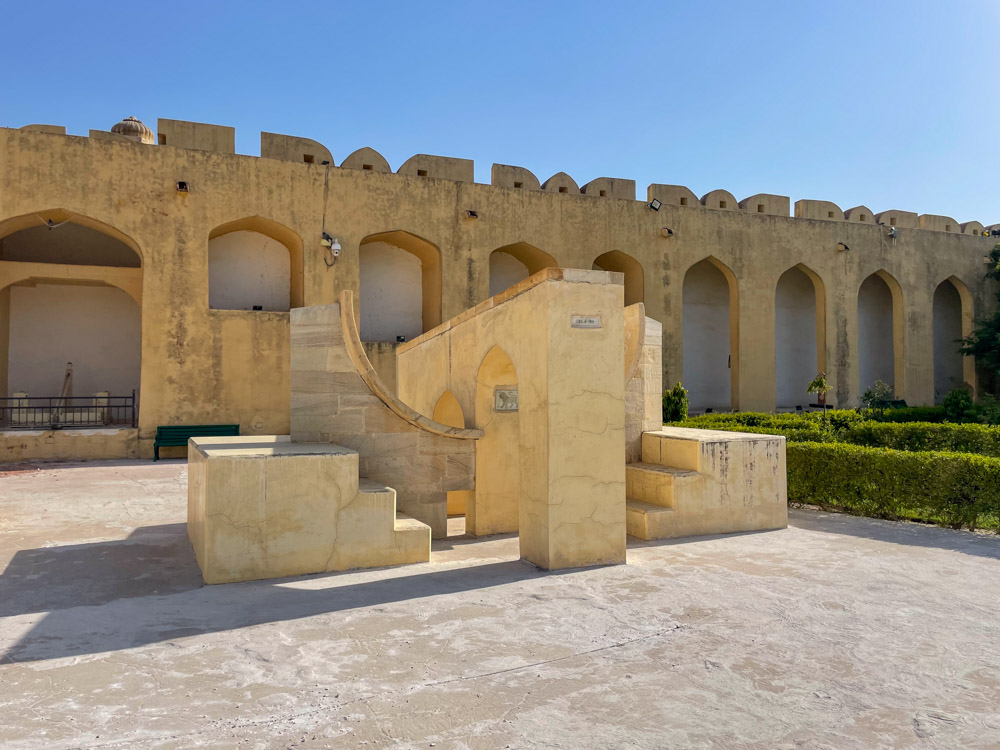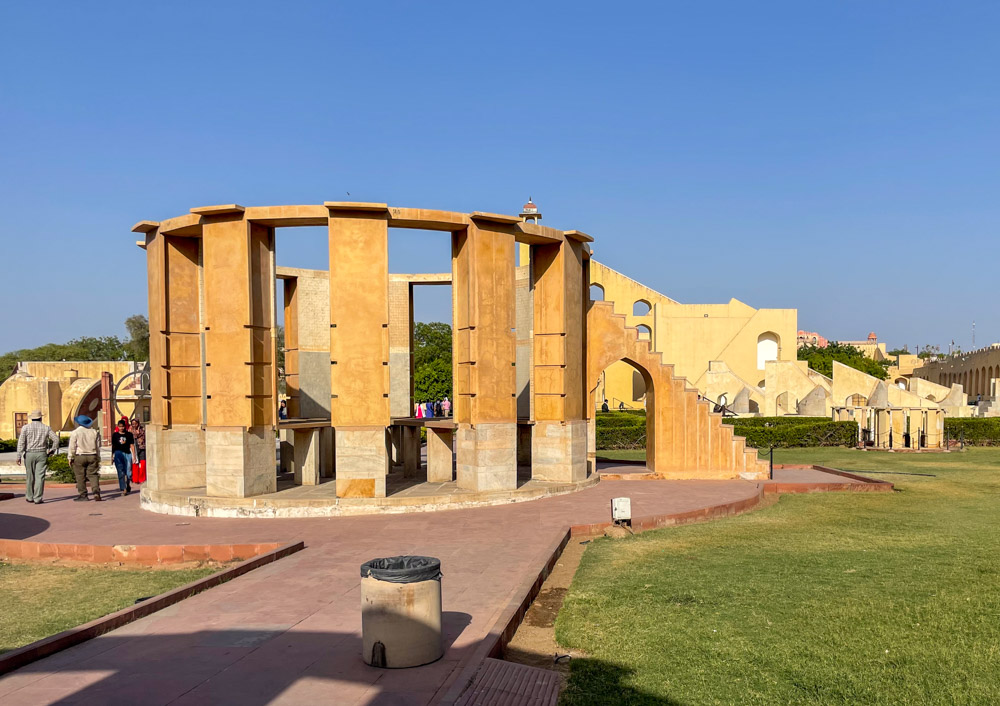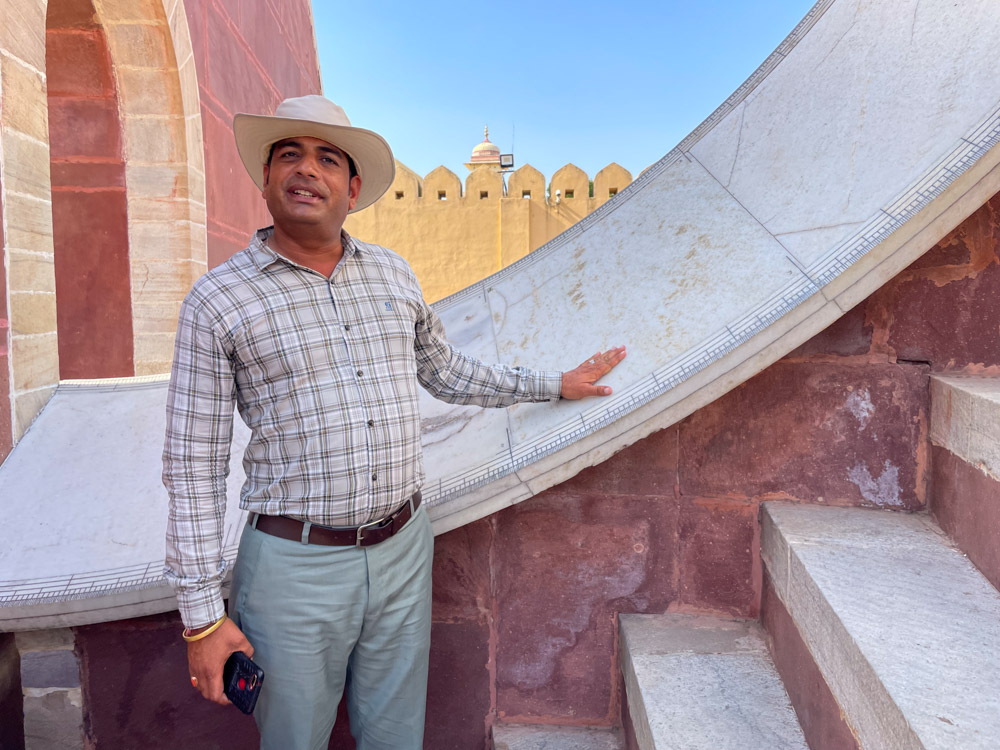If you are in Jaipur, a visit to the Jantar Mantar is a must. Maharaja Jai Singh II designed this unique engineering and architectural marvel in the 18th century to accurately determine the position of celestial objects. The complex houses incredible astronomical instruments that measure different aspects of the sky. The Jantar Mantar is now a UNESCO World Heritage Site. It offers a fascinating insight into the science of astronomy. So, if you want to learn about the sky and its wonders, this is the place to be.
Table of Contents
Jantar Mantar: from astronomical passion of Maharaja Jai Singh to UNESCO World Heritage Site
Jantar Mantar, the astronomical observatory in Jaipur, was built between 1727 and 1734 at the behest of Maharaja Jai Singh II. It is modelled on similar structures erected in Delhi and other Indian localities of the same name. Jantar Mantar means ‘instrument of calculation’. Jantar comes from the Sanskrit word yantra, which translates as ‘instrument, machine’. Conversely, Mantar derives from mantrana and means ‘to consult, to calculate’.
PLAN YOUR TRIP TO INDIA
When in India, stay connected at the best rates by purchasing an Airalo eSIM online before your trip. This eliminates the hassle of purchasing a physical SIM at the airport.
About travel insurance, Heymondo is the way to go. They offer comprehensive coverage against unexpected events like medical emergencies, trip cancellations, lost luggage, and more. Heymondo provides excellent value for money and will give you peace of mind on your travels!
Jai Singh, an Indian king, built five astronomical observatories in Delhi, Ujjain, Mathura, Varanasi, and Jaipur. These observatories were instrumental in creating astronomical tables for measuring time and seasons for over a century. The Jaipur Observatory is the largest and best-preserved of all five and is famous for having the world’s largest stone sundial.
The astronomical instruments at Jantar Mantar allow observation of astronomical positions with the naked eye. In later centuries, the Jaipur Observatory was alternately renovated and abandoned. Since 1961, the Archaeological Sites and Monuments Act of Rajasthan has managed the place. Since 1968, it has become the National Monument of Rajasthan and, since 2010, has been a UNESCO World Heritage Site for its outstanding architecture.

The astronomical instruments of Jantar Mantar in Jaipur
The Jaipur Astronomical Observatory provides an intriguing insight into the field of ancient astronomy. The Jantar Mantar comprises nineteen monumental instruments. They were used to measure time, predict eclipses, track the position of major stars during the Earth’s orbit around the sun, determine planetary declinations, and calculate celestial altitudes and relative ephemerides.
These instruments are mostly monumental structures made mainly of local stone and marble, with astronomical scales engraved on the marble lining. Other instruments are made of bronze, brick and mortar. Their massive size was designed to increase their accuracy and to allow the observation of astronomical positions without any telescope.
One of the principal astronomical instruments at Jantar Mantar is the Samrat Yantra, a spherical sundial among the most precise in the world. Thanks to the shadow moving inside the sundial at one millimetre per second, it can tell the time with an accuracy of about two seconds to local Jaipur time. During your visit, you can stop and watch the movement of the shifting shadow.
The Raj Yantra is a 2.43-metre bronze astrolabe used to calculate the Hindu calendar. The other instruments measure the sun’s azimuth, calculate the time of sunrise and sunset, observe the North Star, measure the latitude and longitude of celestial bodies, and give you a few examples.

The importance of astronomy in Indian culture
The Mantar Jantar is no mere whim of an astronomy-loving maharaja. In Indian culture, astronomy still significantly guides people in various aspects of their lives, from personal relationships to professional choices.
Indian astrology, like Western astrology, is based on the belief that the positions of the celestial bodies at the time of a person’s birth influence their personality. Knowing one’s birth chart allows one to make the best decisions for a successful path in various areas, from choosing a suitable career to finding a perfect marriage match.
Consulting an astrologer is common among Indians, and astrology is integral to many traditions and rituals. For instance, it is common for parents to consult an astrologer when they need to choose a name for their child or determine an auspicious time for important events, such as marriage. In India, as our guide explained, people also seriously turn to astrology to resolve disputes, offer guidance in complex situations and promote personal growth.

Practical information for visiting Jantar Mantar
The Jantar Mantar in Jaipur is a must-see for all history and science lovers. Born as an astronomical observatory, it is a major tourist attraction and a significant historical monument today. Before visiting it, I had no idea how interesting it could be. Its architectural structures are genuinely fascinating and leave you speechless.
During your visit to Jantar Mantar, I advise you to protect yourself from the sun with sunscreen and a hat and take a bottle of water with you because the whole complex is in full sunlight, working thanks to the shadows generated by the sunlight.
Opening hours are from 9 am to 4.30 pm, but to avoid the hottest hours, it might be a good idea to visit the Jantar Mantar complex in the morning before other attractions in Jaipur. Also, plan your visit on a clear day, as the instruments work best under a sky without heavy clouds.
Hire an astronomical guide
Visiting the Jantar Mantar observatory in Jaipur is an extraordinary experience, even if you are not into astrology or ancient history. The astronomical instruments are truly monumental architectures that do not go unnoticed. However, to understand how they work, you need to be accompanied by a specialised astronomical guide.
The Jantar Mantar is a UNESCO World Heritage historical monument and an astronomical observatory of extraordinary precision that still functions today. Our astronomical guide, selected by our Rajasthan tour guide, was instrumental in guiding us around the various instruments and understanding the importance of astronomy and astrology in Indian culture.
Would you happen to need a trustworthy astronomical guide? In that case, you can ask for information at the ticket office. An experienced guide will make a difference and make your visit even more memorable.

How to reach Jantar Mantar in Jaipur
Jantar Mantar, Jaipur’s astronomical observatory, is located near the City Palace in the heart of Jaipur’s vibrant Pink City, a short distance from the Hawa Mahal Palace of the Winds. You can reach it on foot because of its short distance from other tourist attractions. Alternatively, by tuk-tuk, as traffic in this area can be heavy. Remember that walking the streets of India is less pleasant than in other destinations.
Jantar Mantar
Gangori Bazaar, J.D.A. Market
Pink City, Jaipur, Rajasthan 302002, India
Jantar Mantar stands majestically as a monument of Indian astronomy and history between past and present. This unique UNESCO heritage site is an experience to do in Jaipur. Let me know in the comments your thoughts on the ancient astronomical observatory designed by Maharaja Jai Singh. And also, if you have already seen it live.

2 comments
“Astronomy lovers ke liye ek must-visit heritage site.”
Totally! It was really frosting on the cake of our tour